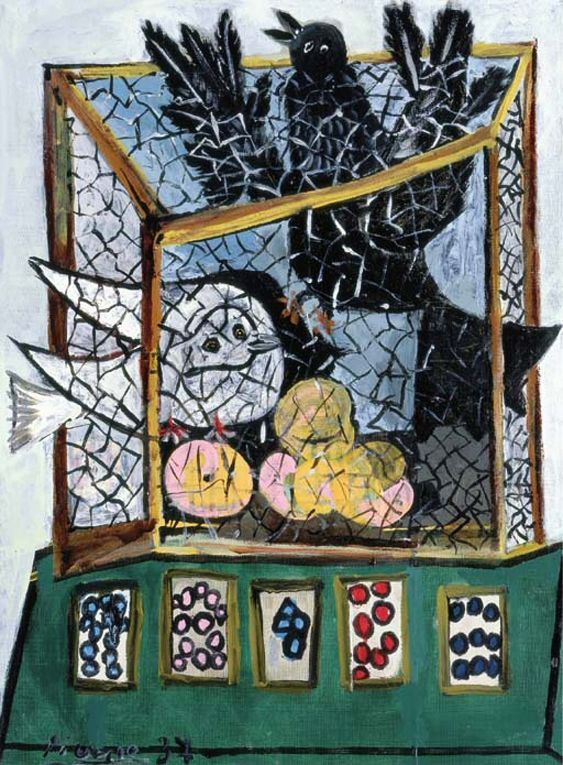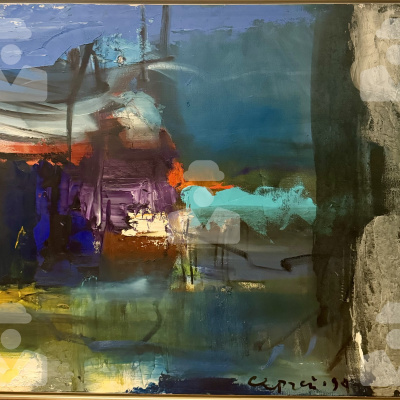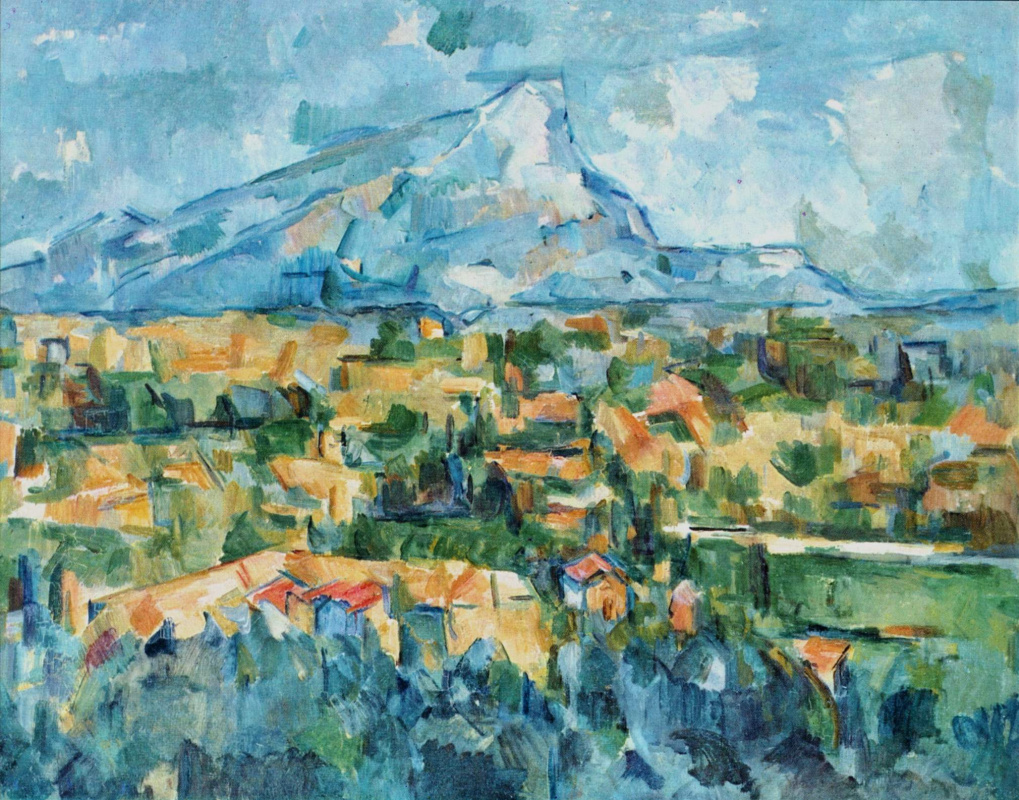Why did Picasso smoke cigars? What fight did the master of modern art recall all his life with delight? Which fingers did he and Chagall give each other at their last friendly dinner? Who helped him escape prison for stealing a famous artwork? And the most important thing: what of all this is true?


Picasso at the beach, Golfe-Juan, 1948. Photo by Robert Capa.
How Picasso died, being barely born
"All children mythologize their birth." So begins an incredibly exciting story in Diane Setterfield’s book The Thirteenth Tale. And with the same words, without fearing to make a mistake or bending the truth, one could begin an early life section of any biography of Pablo Picasso. The artist never missed an opportunity to tell a funny but slightly creepy story about his birth. However, he occasionally "confused testimony," and sometimes claimed that it happened exactly at midnight (just for effect).The day of birth of the first child almost became one of the most tragic moments for the Ruiz family. The boy did not breathe, neither did he cry, and he was considered stillborn. If it had not been for the bad habit of his uncle Salvador, who was a doctor in the room at the time, one of the greatest artists of abstract and modern art might never have come to life. This delicate process did not seem to the doctor a worthy reason to put aside his cigar. And when the infant, showing no signs of life, was placed on the table, Dr. Salvador leaned over him… and blew smoke right into his little face. Picasso started grimacing and launched his long-awaited first cry. Some of Picasso’s biographers claim that it was in memory of this first breath that the artist had never parted with cigarettes and cigars in his life. That, however, did not prevent him from living a long and happy life in spite of any blue periods.

Picasso in his childhood, circa 1886.
Picasso and his first word
A huge role in creating the numerous myths that surrounded the artist’s name was played by his mother. Pablo was the first child and the only boy in the Ruiz family (later Maria Picasso gave birth to two daughters, Lola and Conchita). No wonder that the artist’s mother doted on him. Once, in a letter to her adult son, Maria wrote: "I heard you write poems now. Well, we can expect anything from you. If I’m told that you conducted a church service, I will believe it, too "Maria Picasso took great pleasure in talking about what Pablo was like in his early life. For example, about his appearance: "He was so handsome, like an angel and a demon at the same time, that it was difficult to shift glance from him." Picasso’s father José Ruiz, in turn, paid little attention to the beauty of his son, but was very happy about his keen interest in painting. The failed artist became Pablo’s first teacher and mentor. When the boy turned 13, don José gave up painting entirely and, handing Pablo his brush and palette, declared that his son got ahead of him. According to legend, Pablo had hardly learned to speak before he started drawing. As a child, he rarely played with other kids, preferring to sit on the ground and draw lines and patterns in the dust in his own art style. According to Picasso’s mother, the first word of the future master of Cubism and abstract art was "piz" when he was trying to say "lápiz", the Spanish word for pencil.
Birds in a cage
1937, 81.5×60.7 cm
How women tussled over Picasso
The genius of Cubism and abstract art met the 17-year-old Marie-Thérèse Walter in the street. He followed the young blonde for a long time, then stopped her and immediately pulled out the trump card: "I am Picasso!" At that time, the 45-year-old painter of abstract art got used to having various privileges of his position in society and was extremely surprised when it turned out that the girl had no idea who he was and what his art style was like. But Picasso still easily got across to her. As it always happened with him, no matter was it his Blue period or the Rose one.They kept their relationship a secret for a long time, since at the beginning, Marie-Thérèse was still under age, and Picasso was married to Olga Khokhlova. Even when his young lover became pregnant, the artist couldn’t bring himself to divorce, because it would deprive him of half his property, including paintings. Moreover, at about the same time, a new muse appeared in Picasso’s life — Dora Maar. Once, the women met accidentally in the artist’s studio and after a cross-talk demanded that he choose between them. Picasso told Dora and Marie-Thérèse that they would have to fight it out themselves, at which point the two women began to wrestle. The artist described it "as one of his choicest memories" and even dedicated the painting Birds in a Cage (1937) with black and white doves to it.

Pablo Picasso and Marc Chagall.
How Picasso ran afoul of Chagall
The friendship of two great artists of modern art was destroyed by a single dinner and a few words said in a heat of the moment. Later, none of them missed a chance to sting the offender and his art style. Before, they shared a friendly relationship for many years and didn’t hesitate to call each other geniuses.One day, Picasso said: "When Henri Matisse dies, Chagall will be the only painter left who understands what color really is. I’m not crazy about his roosters and asses and flying violinists, and all the folklore, but his canvases are really painted, not just thrown together. Some of the last things he’s done in Vence convince me that there’s never been anybody since Renoir who has the feeling for light that Chagall has."
That fateful evening of 1964, Picasso and Françoise Gilot came to Chagall’s place for the dinner. After a fair amount of wine, the guest unexpectedly asked his host: "When are you going back to Russia?" "After you," said Chagall with a smile. "I hear you are greatly loved there but not your work. You try to make it there and I’ll wait and see how you do." Being angry, Picasso made a caustic remark: "I guess with you it’s a question of business. You won’t go unless there’s money in it." Françoise Gilot, who was at the table, said that Chagall grinned at that remark but burned inside ever after. That was the end of the friendship between Picasso and Chagall.
How Picasso stole Mona Lisa
They say that for a long time, the recognized masterpiece by Leonardo da Vinci was not really a recognized masterpiece. Mona Lisa became famous largely because no one had seen it for two years. Back in 1911, the famous artwork was not surrounded by the crowd of tourists in a gallery, neither was it protected by bullet-proof glass or an alarm system. Therefore, a certain Vincenzo Perugia (according to some data, he was an employee at the Louvre, according to the other — a glazier) managed to remove the painting from the wall of the gallery and get it out of the museum unobserved. It is believed that the thief wanted to restore historical justice, sending one of the most invaluable of the art pieces to Italy.In an unsuccessful search for La Gioconda, the police kept an eye on any leads that they might see. For example, a couple of phrases told by close friends Guillaume Apollinaire and Pablo Picasso in a fit of temper: they said that the Louvre had to be set on fire. The poet was arrested first. After many hours of interrogation, Apollinaire, either jokingly or out of despair, pointed at Picasso as a possible thief. The Cubist artist was also taken into custody, but the Paris police did not manage to beat a false confession to the theft out of him. Both Picasso and Apollinaire were soon released, but they were called in for questioning several times. Interestingly, this fact did not affect the friendship between the artist and the poet — it lasted until the very death of Apollinaire in 1918. Moreover, there were rumors that the police so quickly released them from custody due to Gertrude Stein’s intervention.
Almost cubism: Paul Cézanne. Mont Sainte-Victoire, 1904
Picasso and his "only teacher"
The seminal moment for the artist was the Paul Cézanne retrospective held at the gallery of Salon d’Automne in 1907. Of course, Picasso had seen the paintings of the great Frenchman before, but, according to the artist himself, it was not until the retrospective that he experienced the full impact of Cézanne's art style and artistic achievement. As Picasso later put it: "Cézanne's influence gradually flooded everything."According to many art critics, the appearance of cubism is owed to Cézanne's work. His reduction of the visible world into basic, underlying shapes, the faceted brushstrokes, the fracture and flattening of space — all these can be seen as the beginnings of modern art. In Cézanne's work Picasso found a model of how to distill the essential from nature in order to achieve a cohesive surface that expressed the artist’s singular vision. In 1907, Picasso began to experiment with Cézanne's techniques alongside fellow artist Georges Braque. Cézanne was a constant touchstone for the two artists during the whole period of their collaboration at the cradle of the Cubism .
Many years later, in conversation with a journalist, Picasso echoed this view: "It's not what the artist does that counts, but what he is. Cézanne would never have interested me a bit if he had lived and thought like Jacques-Émile Blanche, even if the apple he painted had been ten times as beautiful. What forces our attention is Cezanne’s anxiety — that’s Cezanne’s lesson."
Title illustration: Pablo Picasso. Bread Hands. Vallauris, 1952. Photo by Robert Doisneau.
Author: Yevheniia Sidelnikova















